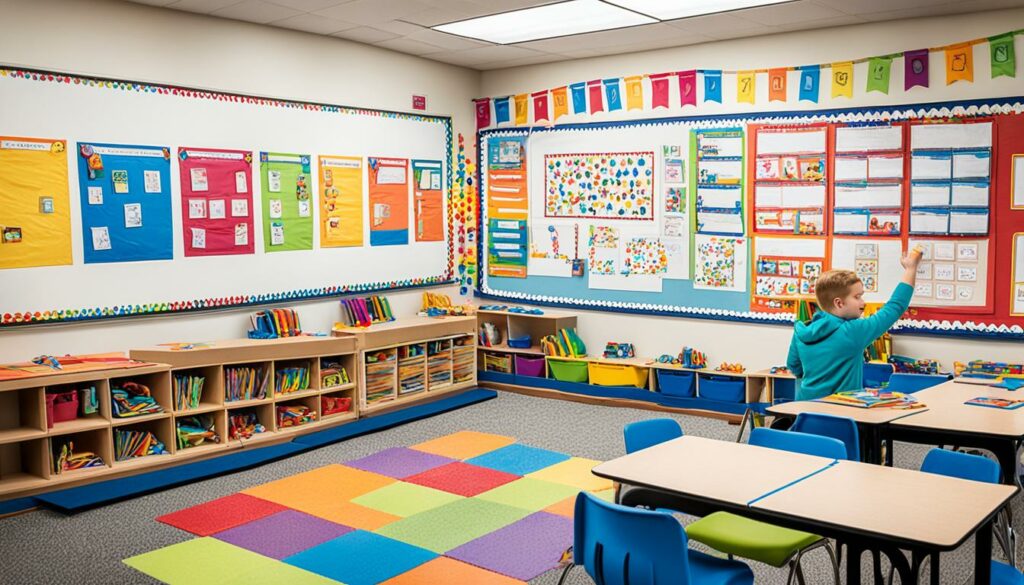Do you know the common symptoms of ADHD in children? And are you familiar with the most effective support strategies to help them thrive? While ADHD, or attention-deficit/hyperactivity disorder, affects millions of children worldwide, there are still misconceptions and challenges surrounding its understanding and management. In this article, we will delve into the symptoms of ADHD in children and explore the strategies that parents and teachers can implement to provide the best support. Get ready to discover a whole new perspective!
Key Takeaways:
- ADHD is a chronic condition that can impact attention span, hyperactivity, and impulse control in children.
- Children with ADHD may also experience low self-esteem, school anxiety, and poor performance.
- Treatment for ADHD typically involves a combination of medications and behavioral interventions.
- Support strategies for ADHD in children include giving praise and rewards, providing clear directions, establishing healthy habits, developing routines, and promoting social skills and friendships.
- By understanding ADHD symptoms and implementing effective support strategies, parents and teachers can help children with ADHD thrive in school and in life.
What is ADHD?
ADHD, or attention-deficit/hyperactivity disorder, is a neurobehavioral disorder that primarily affects children, although it can continue into adulthood. It is characterized by difficulties in sustaining attention, hyperactivity, and impulsivity. ADHD can significantly impact a child’s academic performance, social interactions, and overall quality of life.
There are three subtypes of ADHD, each with its own unique symptoms:
- Inattentive ADHD: This subtype is characterized by symptoms of inattention without significant hyperactivity or impulsivity. Children with inattentive ADHD often have trouble focusing, staying organized, and following instructions. They may appear dreamy or forgetful, struggling to complete tasks or pay attention to details.
- Hyperactive/Impulsive ADHD: This subtype involves symptoms of hyperactivity and impulsivity without significant inattention. Children with hyperactive/impulsive ADHD may struggle to sit still, constantly fidget, talk excessively, and interrupt others. They may act before thinking, engaging in risky or impulsive behavior.
- Combined ADHD: This is the most common subtype of ADHD, characterized by a combination of symptoms from both inattentive and hyperactive/impulsive types. Children with combined ADHD often exhibit inattention, hyperactivity, and impulsivity. They may struggle with executive functioning skills, such as planning, organizing, and self-control.
It’s important to note that ADHD symptoms can vary in severity and may change over time. A comprehensive evaluation by a healthcare professional is necessary to diagnose ADHD accurately. Early identification and appropriate interventions can significantly improve the overall well-being and academic success of children with ADHD.
| ADHD Subtype | Key Symptoms |
|---|---|
| Inattentive ADHD | Symptoms of inattention, organization difficulties, forgetfulness |
| Hyperactive/Impulsive ADHD | Symptoms of hyperactivity, restlessness, impulsivity |
| Combined ADHD | Symptoms of inattention, hyperactivity, impulsivity |
Gender Differences and ADHD

ADHD diagnosis reveals interesting gender differences—boys are more commonly diagnosed with ADHD compared to girls. However, as individuals reach adulthood, the gender gap narrows, with ADHD prevalence becoming almost equally balanced between men and women.
Girls with ADHD often present with the inattentive form of the disorder, which may contribute to a lower diagnosis rate during childhood. Many women only recognize their ADHD after a child in their life is diagnosed or when they notice similar behavior patterns within themselves.
Understanding gender differences in ADHD is vital for providing appropriate treatment and support. By recognizing the unique manifestations of ADHD in boys and girls, individuals can seek help tailored to their specific needs.
Now, let’s delve into the gender-specific characteristics of ADHD in boys and girls.
| ADHD in Boys | ADHD in Girls | |
|---|---|---|
| Prevalence | Higher prevalence rate | Lower prevalence rate |
| Symptoms | Hyperactivity, impulsivity, inattention | Inattention |
| Diagnosis Challenges | Evident outward behaviors | Less noticeable symptoms |
| Recognition | Often identified earlier | May go unnoticed or misdiagnosed |
| Impact on Self-Esteem | Hyperactive behavior can lead to external negative feedback and potential self-esteem challenges | Tendency to experience internalized symptoms, potentially affecting self-worth and confidence |
ADHD Treatment

While there is no cure for ADHD, there are effective treatments available to help manage symptoms in children. These treatments primarily include medications and behavioral interventions.
Medications, such as stimulants or non-stimulants, can be prescribed to children with ADHD to improve attention, reduce hyperactivity, and manage impulsivity. Stimulants, like Adderall or Ritalin, work by increasing dopamine and norepinephrine levels in the brain, leading to improved focus and reduced hyperactivity. Non-stimulants, such as Strattera, work by increasing norepinephrine levels, providing similar benefits without the stimulant effect.
In addition to medications, behavioral interventions play a crucial role in managing ADHD symptoms and promoting positive behavior. These interventions can be implemented by parents and teachers to create a structured and supportive environment for children with ADHD.
Some key interventions include:
- Praise and rewards: Providing positive reinforcement and acknowledging good behavior can motivate children with ADHD.
- Clear directions: Offering concise and specific instructions can enhance understanding and task completion.
- Healthy habits: Encouraging regular exercise, a balanced diet, and sufficient sleep can contribute to overall well-being.
- Routines: Establishing consistent schedules and routines can help children with ADHD stay organized and focused.
- Social skill development: Assisting children in building social skills and friendships can improve their relationships and self-esteem.
By combining medications and behavioral interventions, children with ADHD can effectively manage their symptoms and thrive in various aspects of life, including academics, social interactions, and personal development.
“The right combination of medication and behavioral interventions can significantly enhance the quality of life for children with ADHD.” – Dr. Jane Thompson, Child Psychiatrist
| Treatment Method | Description | Benefits |
|---|---|---|
| Medications | Prescribed drugs such as stimulants or non-stimulants that help improve attention and reduce hyperactivity and impulsivity. | – Increased focus – Reduced hyperactivity – Improved impulse control |
| Behavioral Interventions | Strategies implemented by parents and teachers to manage ADHD symptoms, such as setting routines, providing clear directions, and promoting social skills. | – Improved behavior management – Enhanced organizational skills – Increased self-esteem |
Behavioral Strategies for ADHD
Implementing effective behavioral strategies is crucial for managing ADHD symptoms in children. These strategies can greatly improve their self-esteem, academic performance, and overall well-being.
Give Praise and Rewards
Positive reinforcement plays a key role in shaping behavior. Offering praise and rewards when children with ADHD follow rules and demonstrate good behavior helps motivate them and reinforces positive actions.
Provide Clear and Effective Directions
Children with ADHD often struggle with following instructions. Using clear and concise language when giving directions or commands can greatly enhance their understanding and compliance. Breaking down complex tasks into smaller, manageable steps can also be helpful.
Establish Healthy Habits
A consistent routine that includes regular sleep and exercise can significantly benefit children with ADHD. Adequate sleep and physical activity help improve focus, concentration, and self-regulation.
Develop Routines
Structured routines are essential for children with ADHD as they provide a sense of predictability and help them better manage their time and responsibilities. Establishing routines around homework, chores, and other daily activities can reduce stress and promote organization.
Help Build Relationships and Social Skills
Children with ADHD may struggle with social interactions and making friends. Encouraging and facilitating opportunities for them to engage in social activities can boost their social skills and help them establish meaningful relationships.
“Implementing behavioral strategies such as praise, clear directions, healthy habits, routines, and social skill development can greatly improve the well-being and academic performance of children with ADHD.” – Dr. Sarah Johnson, Child Psychologist
By adopting these behavioral strategies, parents, teachers, and caregivers can create a supportive environment that helps children with ADHD manage their symptoms and thrive.
Classroom Strategies for ADHD Students

Children with ADHD often face unique challenges in the classroom, but with the right strategies and support, they can thrive academically. Teachers play a crucial role in creating an inclusive learning environment that caters to the individual needs of students with ADHD.
Behavioral Classroom Management
One effective approach is implementing behavioral classroom management techniques. This involves establishing clear expectations and rules, reinforcing positive behaviors, and discouraging negative behaviors. By providing consistent structure and predictability, students with ADHD can better understand and meet behavioral expectations. This can be achieved through a variety of strategies, including:
- Using visual supports, such as charts or schedules, to help students stay organized and understand daily routines.
- Implementing a token economy system, where students earn rewards for meeting specific behavioral goals, reinforcing positive behaviors.
- Creating a calm and supportive classroom environment that minimizes distractions and ensures students can focus on their tasks.
Organizational Training
Another key aspect of supporting students with ADHD in the classroom is providing organizational training. Organization skills are essential for academic success, and students with ADHD often struggle in this area. Teachers can help by:
- Teaching students how to use tools like planners or digital calendars to manage assignments and deadlines.
- Breaking down complex tasks into smaller, manageable steps and teaching students how to prioritize and plan their work.
- Providing clear and detailed instructions, both verbally and in written form, to enhance comprehension and reduce confusion.
Special Education Services and Accommodations
In addition to behavioral strategies and organizational training, it is important to offer special education services and accommodations to meet the unique needs of students with ADHD. These services may include:
- Individualized Education Programs (IEPs) or 504 Plans that outline specific accommodations, such as extended time for assignments or preferential seating.
- Providing assistive technologies, such as text-to-speech software or graphic organizers, to support reading and writing tasks.
- Offering small group or one-on-one instruction to provide additional support and personalized attention.
By implementing these strategies and providing the necessary support, teachers can create a positive learning environment that promotes success for students with ADHD.
Table
| Classroom Strategies for ADHD Students | Description |
|---|---|
| Behavioral Classroom Management | Establish clear expectations, reinforce positive behaviors, and discourage negative behaviors. |
| Organizational Training | Teach organization skills, provide clear instructions, and assist with planning and prioritizing tasks. |
| Special Education Services and Accommodations | Offer individualized support, accommodations, and assistive technologies to meet the unique needs of students with ADHD. |
Tips for Teachers in Supporting ADHD Students
As a teacher, I understand the importance of providing support to students with ADHD. Here are some strategies that can make a significant impact on their success in the classroom:
- Give frequent feedback and attention: Recognize and praise positive behavior to reinforce their efforts and boost their self-esteem.
- Be sensitive to the impact of ADHD on emotions: Understand that students with ADHD may struggle with regulating their feelings. Create a safe and supportive environment where they feel understood and accepted.
- Provide warnings before transitions and changes in routines: Help them prepare for transitions by giving them advance notice, so they can mentally prepare and adjust accordingly.
- Understand hyper-focus and help students shift their attention: Students with ADHD may experience hyper-focus on certain tasks or topics. Help them recognize when it’s time to shift their attention to other areas of learning.
- Give clear assignments and provide choices for mastery: Break down instructions into smaller, manageable tasks, and offer options for students to demonstrate their understanding and skills.
- Allow breaks and movement: Incorporate regular breaks and movement activities into the daily routine to help students release energy and stay engaged.
- Minimize distractions in the classroom: Create an organized and clutter-free environment to reduce potential distractions and promote better focus.
- Use organizational tools: Help students develop organizational skills by providing visual aids, planners, checklists, and other tools that can assist in managing their tasks and responsibilities.
- Involve the school counselor or psychologist when needed: Work collaboratively with the school’s support staff to develop individualized plans and strategies that address the specific needs of students with ADHD.
By implementing these strategies, teachers can create an inclusive and supportive classroom environment that facilitates the success of students with ADHD.
| Strategy | Benefits |
|---|---|
| Give frequent feedback and attention | Boosts self-esteem and reinforces positive behavior |
| Be sensitive to the impact of ADHD on emotions | Creates a supportive environment and promotes emotional regulation |
| Provide warnings before transitions and changes in routines | Helps students prepare and adapt to transitions more effectively |
| Understand hyper-focus and help students shift their attention | Fosters flexibility and a balanced approach to learning |
| Give clear assignments and provide choices for mastery | Promotes understanding, engagement, and autonomy |
| Allow breaks and movement | Enhances focus, energy release, and classroom participation |
| Minimize distractions in the classroom | Supports better concentration and attention |
| Use organizational tools | Develops essential organizational skills for academic success |
| Involve the school counselor or psychologist when needed | Accesses specialized support and resources |
Parent Education and Support for ADHD
As a parent of a child with ADHD, it is essential to equip yourself with the knowledge and resources necessary to understand and support your child’s needs. By advocating for your child and collaborating with teachers and healthcare providers, you can ensure that they receive the best possible care and support. Below are some key strategies and resources to help you on this journey.
Understanding ADHD and Diagnosis
Take the time to educate yourself about ADHD, its symptoms, and how it affects children. This understanding will better equip you to address your child’s needs effectively. Additionally, familiarize yourself with the process of diagnosing ADHD and the criteria used.
Individualized Education Programs (IEPs) and 504 Plans
Learn about the role of IEPs and 504 Plans in supporting students with ADHD in school. These programs provide a framework for accommodations and services tailored to your child’s specific needs. Work closely with your child’s school to develop and implement an effective plan.
Advocating for Your Child
As a parent, you are your child’s greatest advocate. Team up with their teachers and healthcare professionals to ensure their needs are met at home, in school, and in the community. Effectively communicate your child’s strengths, challenges, and individual needs to those involved in their care.
Communication and Documentation
Regular communication with your child’s teachers is crucial for staying informed and addressing challenges promptly. Share insights about your child’s progress, discuss any concerns, and collaborate on strategies. Keep records and documentation of important conversations, evaluations, and accommodations to maintain a clear and comprehensive overview of your child’s ADHD journey.
Homework and School Projects
Create a system that supports your child in completing homework assignments and long-term projects. Break tasks into manageable chunks, provide structure and routine, and offer guidance when needed. This proactive approach will help your child stay organized and focused.
ADHD Resources for Parents
| Resource | Description |
|---|---|
| CHADD (Children and Adults with Attention-Deficit/Hyperactivity Disorder) | CHADD is a leading nonprofit organization providing support, resources, and advocacy for individuals with ADHD and their families. Their website offers a wealth of information, virtual support groups, and educational materials for parents. |
| Understood | Understood is an online resource specifically designed for parents of children with learning and attention issues, including ADHD. It provides expert advice, educational resources, and a supportive community for parents. |
| National Resource Center on ADHD | This resource center, funded by the Centers for Disease Control and Prevention (CDC), offers evidence-based information on ADHD for parents, healthcare professionals, and educators. It provides access to online courses, webinars, and fact sheets. |
Utilize these resources to access reliable information, connect with other parents facing similar challenges, and find guidance on navigating the complexities of raising a child with ADHD.
Remember, you are not alone on this journey. By educating yourself, advocating for your child, and accessing available resources, you can provide the support and guidance your child needs to thrive despite the challenges of ADHD.
Conclusion
ADHD is a complex condition that can significantly impact the lives of children. However, with the right support strategies in place, children with ADHD can navigate their symptoms and thrive in school. By implementing a combination of behavioral strategies, classroom accommodations, and parental support, we can create a supportive environment that meets their individual needs.
Parents play a crucial role in advocating for their child and collaborating with teachers and healthcare providers. Regular communication, understanding the diagnosis, and utilizing the resources available can empower parents to effectively support their child’s education. Additionally, teachers can implement various strategies, such as providing positive reinforcement, offering clear instructions, and minimizing distractions, to create an inclusive and supportive classroom environment for students with ADHD.
It is essential for parents, teachers, and healthcare providers to work together as a team. By combining their efforts, they can develop individualized strategies that address the unique challenges of each child with ADHD. With the right support, children with ADHD can manage their symptoms, build their self-esteem, and achieve academic success.
